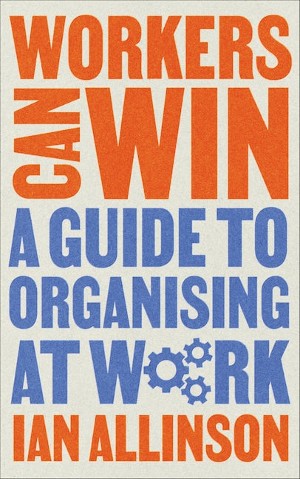 Ian Allinson, Workers Can Win: A Guide to Organising at Work (Pluto Press 2022), 272pp.
Ian Allinson, Workers Can Win: A Guide to Organising at Work (Pluto Press 2022), 272pp.
Workers Can Win is an introduction to trade-union organising which will be very useful for new activists, finds Kevin Crane
The sudden rise and return of workers’ struggles have been one of the only pieces of major news in the past few years that has been a source of hope rather than concern. The 1 February this year was a massive day of industrial action. It comes after the best part of a year of steadily increasing militancy among working people across almost every sector of the economy. This reached from the historically well-organized rail workers to very unlikely groups like criminal barristers. The fightback has been against a ruling-class offensive that openly intends to make workers pay for the mounting failures of capitalism in the age of climate change, pandemics and deglobalisation.
It’s a huge historic turnaround: even during the heights of the struggle against austerity or the left populism around Jeremy Corbyn’s leadership of the Labour Party, the trade-union movement had been in a long slump in Britain, as in much of the Global North. A majority of young workers in this country still have no experience of even the most basic trade-union organising. It’s not that there is a lack of interest: internet search engines show that people have been searching in droves online about how to join trade unions ever since last summer. This is a book aimed at the sorts of people that were asking that question.
Author Ian Allinson not only has plenty of years of experience as a trade-union rep, but has also done exhaustive research on both classic and contemporary studies and reporting into the trade unions, workplaces and workers’ struggle. The book is very much framed by him as a distillation of that collected knowledge. It is structured as a reference book, not a continuous argument, and it is not intended to change anyone’s mind. Rather, it’s a sort of activist’s manual aimed at someone who is already enthusiastic about, but lacking experience in, worker organisation.
The chapters are organised according to particular challenges and issues. Each chapter ends, in the style of a textbook, with a summary of key points raised and a set of questions for the reader to ask themselves. While the chapters do make the most sense read in order, it wouldn’t be strictly necessary to do that to understand each one.
From the basics onward
The early chapters, 1-4, are the absolute basics, and a new starter probably would read these in full. They are very digestible and would answer a lot of the questions that a new union rep, or just someone wanting to be in a union, might have. The middle chapters, 5-9, are likely to be things that one would dip into later on as one is experiencing the realities of actual organising work. Answering the questions at the end of these chapters would be much less abstract, requiring you to research and consider your work environment seriously, and likely begin to canvass the opinions of other workers. This is obviously work in which you have to engage to progress with any organising project.
The later chapters, 10 and 11, are a bit different in tone, being more about both employers and trade unions as institutions. This is the most political part of the book, in the proper sense of the political implications of class relations at work, not the workplace bickering we call ‘office politics’. Chapter 11, in particular, looks at the complicated question of life inside union structures. This includes conflicts and tensions within unions themselves, which is quite simply an unfortunate reality of which you have to be aware and deal with. Rightly, this is a book about organising against exploitative capitalists, not this or that faction within a trade union, but it would have been an error not to deal with this.
The book does not come to some propagandistic conclusion: the final chapter is basically an open ending which discusses how to sustain workplace organising long term, over the course of years in which one will inevitably have ups and downs and need to get through bad times. The intent is very much that the book will be there alongside your rep’s guides and other reference materials, to revisit when you need ideas or answers.
All in all, this book is probably of great interest to anyone who is making those first steps into being a workplace leader. It’s clearly written and its textbook-like structure means that while you’re unlikely to have read it cover to cover in a short time, returning to it to look at specifics is going to be extremely easy to do. It’s also worth saying that Allinson is open and enthusiastic about his sources and influences, so anyone who is inspired to do further reading on any of the issues the book raises can pretty much get a recommended reading list from the book itself, which is also very useful.
Before you go
Counterfire is growing faster than ever before
We need to raise £20,000 as we are having to expand operations. We are moving to a bigger, better central office, upping our print run and distribution, buying a new printer, new computers and employing more staff.

